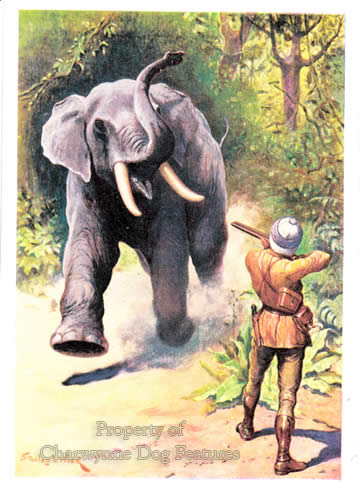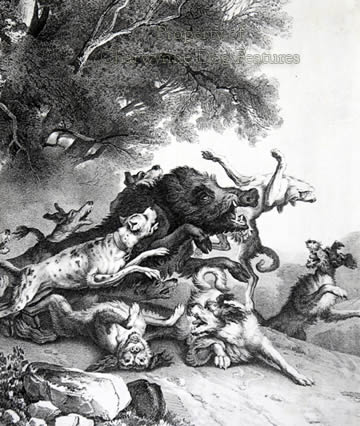873 DOGS' EYE VIEW
DOGS' EYE VIEW
by David Hancock
 How many of us ever consider the view obtained by the sporting dog when facing even traditional quarry? The view from two feet off the ground, or less, is not just much more limited but so often much more alarming. It's not unheard of for shooting men to get cross with gundogs unable to mark game easily spotted by a six foot man but invisible to a two-foot high dog. It's easier to appreciate the task of a heeler rounding up or driving wayward cattle if you too get down on all fours behind a restless heifer or bullock! But in the long-lost days of big-game hunting with dogs, the sheer bravery, as well as extraordinary agility, of the hunting dogs was quite exceptional. In the medieval boar-hunt more dogs were killed than boars, that is why the more expendable 'matins' were used in the final stages ahead of the more precious specially-bred boarhounds. Dogs used in the auroch, hippo and ostrich hunt had a very different task from that of the dogs encouraged to bait the bull, the latter was usually tethered. In the far-eastern stag-hunts of Victorian big-game hunters like Sir Samuel Baker, the hounds used had to combine courage with dexterity, do their master's bidding yet live to hunt another day! They always have a ground floor view.
How many of us ever consider the view obtained by the sporting dog when facing even traditional quarry? The view from two feet off the ground, or less, is not just much more limited but so often much more alarming. It's not unheard of for shooting men to get cross with gundogs unable to mark game easily spotted by a six foot man but invisible to a two-foot high dog. It's easier to appreciate the task of a heeler rounding up or driving wayward cattle if you too get down on all fours behind a restless heifer or bullock! But in the long-lost days of big-game hunting with dogs, the sheer bravery, as well as extraordinary agility, of the hunting dogs was quite exceptional. In the medieval boar-hunt more dogs were killed than boars, that is why the more expendable 'matins' were used in the final stages ahead of the more precious specially-bred boarhounds. Dogs used in the auroch, hippo and ostrich hunt had a very different task from that of the dogs encouraged to bait the bull, the latter was usually tethered. In the far-eastern stag-hunts of Victorian big-game hunters like Sir Samuel Baker, the hounds used had to combine courage with dexterity, do their master's bidding yet live to hunt another day! They always have a ground floor view.
Not surprisingly, dogs with 'bull' in their breed title are renowned for their persistence if nowadays condemned for it by the animal-police. Breeds specifically developed to hunt a fearsome adversary, such as the Dogo Argentino on jaguar, were selectively bred to combine the talents of several breeds, by inspired hunter-breeders like the Martinez brothers. Sanderson used Bull Terrier crosses to control elephants when managing forests in Victorian India. Every contemporary breed of dog now revered for its long record of pure-breeding only became famous and respected due to the mixed blood used in its creation, stand tall lurcher breeders! If you exclude the odious so-called 'sports' of bull, badger and bear baiting, where brainless ferocity was prized in the dogs - ahead of gripping prowess, in grande venerie, the timing of the 'seize' and the sheer stamina needed to get there in the first place, demonstrated quite extraordinary dogs at work. Hunters in Africa could always climb the nearest tree - the dogs had to evade the herd! Ratting enthusiasts can always stand on a chair, ratting terriers are often surrounded, at eye level, by a sea of squirming rodents!
But, despite the wisdom of using dogs in the hunt, I doubt if ignorant journalists would support the use of dogs if boar-hunts were sanctioned in the Forest of Dean. Do you chase the boar, risking your own safety, and strive to get a shot in, accurately - despite undergrowth and a wily, elusive and extremely dangerous quarry, with the risk
of just maiming an enraged quarry. Or, do you enlist trained dogs, whose instinct is to
seize and hold (by the ear) then quickly despatch a restrained animal as humanely as
you can? The way we control wild animals should be based on a desire to inflict the
very minimum of pain but nowadays would have to satisfy the ill-informed consciences of town-dwelling do-gooders. The lingering often agonising death of
foxes wounded by shotgun cartridges is never measured against a speedy despatch by the leading foxhound. Prejudice in any form can over-rule not just plain common
sense but also deny the best outcome. Sportsmen usually respect their quarry, fanatics
only respect their own personally-biased viewpoint. Dogs have a very different
viewpoint both physically and instinctively. 
Man's height gives him immediate advantages over dog and the other four-legged animals, providing not just longer vision but vital extra information. Dogs very much see what is in front of them, although the sighthound's ability to detect distant movement is remarkable. This canine limitation works well at the ground vermin level but is a huge handicap both in the hunting and in the shooting field, although their scenting capability is aided by the closeness of their noses to the ground. It's worth asking yourself the question: when lying on the ground my sense of smell is helped by closer range to the source but could I cope at all with the vast loss of vision, especially over the distance I need it to do my next task? The shoulder height of say a Beagle is often debated but never from a vision point of view, always about optimum scenting height and obstacle-clearing potential. But when facing a formidable adversary, especially one fighting for its life, dog is often also risking its life - entirely at man's behest. When hunting with dogs we gain from their scenting skills, their athletic capability and their utter determination to do the job they are expected to do; we need to be empathetic towards their loss of a longer view but thankful for their courage - who of us would stand their ground when a wild boar is loose?